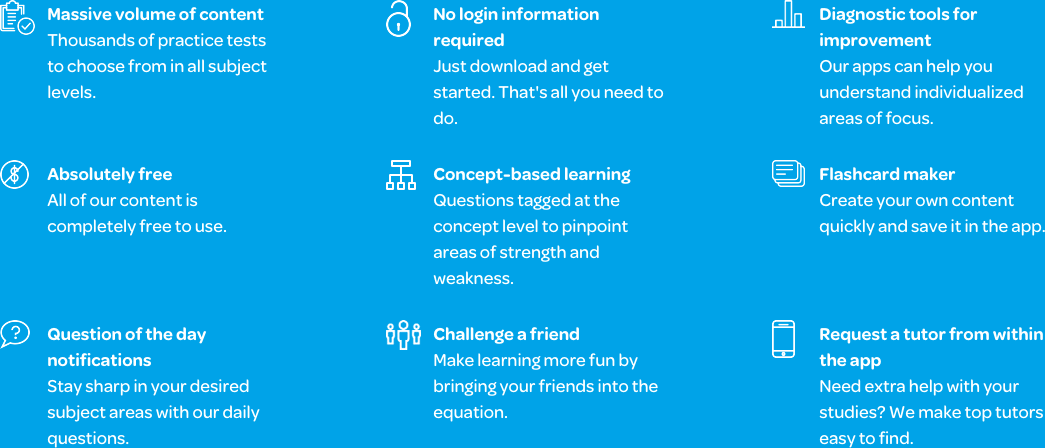The Varsity Tutors AP Microeconomics Mobile App
The Varsity Tutors AP Microeconomics app is available now for Android, iPhone, and iPad on iTunes and the Google Play Store. It provides tools that will give you practice on vital microeconomics concepts. The timed full-length practice tests will help you review basic economics and in understanding important topics that are relevant to the study of microeconomics. These study materials can help you get as close as you can to a 5 on the AP Microeconomics exam. The key is studying the right way, rather than more often, with the most appropriate and relevant tools that cover the exact content you’ll be tested on.
AP Macroeconomics is a comprehensive course covering subjects such as market principles and failure, distribution of income, and the government’s role in the economy. A good bit of the curriculum involves learning to use economic data, often presented in charts and graphs, to analyze and describe the issues at hand. You will also be asked to evaluate outcomes related to price, output, and supply and demand variables, plus wages, interest, factor prices, and rent. From the behavior of companies to public policy promoting competition, the concepts learned are intended to give you a complete picture of how microeconomics affects daily life.
The exam is organized into a format that can seem quite challenging. Within two hours and ten minutes, you will be asked to answer 60 multiple-choice questions that cover various economics concepts and the analysis of hypothetical circumstances. You will also have to complete a free-response section, which consists of one long question and two shorter questions. You must analyze the scenarios presented using the information you’ve learned during the course. You will also have to incorporate the data included in the questions in your analysis and explanation.
There is certainly a lot to learn; you must understand the basic principles, analyses, and applications of various decision-making variables rather than simply memorizing data. You’ll also brush up on market and business equilibrium. Other practice questions cover subjects such as marginal revenue product of labor, positive externalities, and competitive labor and output markets. The Learn by Concept resource and flashcards can be of help in these areas. You can even create your own digital flashcards. The app lets you take pictures of graphs or record audio from a class to help you better understand tough topics.
There are literally hundreds of questions available on the app. These have all been created by economics experts, so you get exactly the practice questions that will truly help you prepare for the test. The experts had AP Microeconomics students in mind when writing the questions, so when you are presented with the multiple choice and free response questions on the exam, you’ll be more equipped to analyze and apply the relevant principles.
The Varsity Tutors AP Microeconomics app for Android, iPhone, and iPad is designed to help you learn, rather than simply memorize. It guides you in learning the answers to questions you get wrong, so you’ll understand the reasoning behind the correct answer. The app enhances the learning process as you work toward the AP Microeconomics exam. Find the app today on iTunes and the Google Play Store.
66 mobile apps to choose from for your tutoring needs.

Learn More
AP Microeconomics is a college-level course that is designed to introduce you to thinking economically. The class allows you to earn college credit while still in high school. It is valuable to many different post-secondary majors, such as insurance, entrepreneurial studies, general business, political science and government, and many others. The goal by the end of the term is to have developed an understanding for the various principles and how they can be applied to decision makers in our economic system.
There are four primary principles that you'll learn in AP Microeconomics, each of which place a focus on the purpose of product markets, how the government plays a role in economic equity and efficiency, and the study of factor markets. Each major topic has additional material designed to help you develop a clear understanding of these ideas. In addition, you should be able to illustrate the principles in order to provide evidence during concept tests and the final exam.
At the end of the program, you are given a two-hour final exam. It has a multiple-choice section that allows you 70 minutes to complete it. The second half of the AP Microeconomics exam is a one-hour free-response section. You may be required to analyze graphs, create diagrams to back up your response, use explanation skills to explain your economic reasoning, identify a specific answer from a label or list, and use mathematical reasoning to support your answers.
The first area of study you'll be diving into covers basic economic concepts that are mandatory to progress into more complex areas of the course. During these first few weeks, you'll be introduced to concepts that focus heavily on the requirement of making hard choices when you run an economy. You start off with key topics, such as trade-offs and the expense of opportunity. You'll need to learn how to produce possibility curves and other forms of analytical illustration. From there, you'll learn about different kinds of economies. Each has a different way of identifying what they will offer, how to offer it, and who the target customer is. In addition, you'll be taught the differences between comparative and absolute advantages, how trade can be mutually advantageous, how specialization can increase output of the goods and/or services, marginal analysis, property rights, and the role of incentives in the free market.
Following your introduction to the basics, you'll learn about the nature and function of product markets in the economy. There are four general topic areas that you'll learn about during this section of the class: theory of the firm, consumer choice, supply and demand models, and production and costs. If well-planned, your teacher should spend more time in this area than in the previous. It is important to analyze how determinants of supply and demand can cause changes to output and pricing. You'll learn to identify shifts and movements in the curves; understand how the government's policies play a role in taxes; quotas; price minimums and maximums impact the free market in terms of quantity and pricing; and the concepts of price and income elasticities of supply and demand, cross-price, and price.
Following this, your teacher will introduce you to the theory of consumer choice. There are many sub-concepts that consumer choice touches on, such as utility, how marginal utility diminishes, what conditions maximize utility, and how these concepts can be applied to the law of demand and decision making. You will need to be able to demonstrate an understanding of the methods used to derive a person's individual demand curves, how market and individual demands relate, and how income impacts the demand curve.
The supply and demand model section of the class is the third area of study, and it discusses cost and production analysis for short and long term. The introduction to short-term production functions delves into how input and output quantities correlate. You'll need to understand the law of diminishing marginal return, as well as marginal and average products. During this part of the class, you'll be tasked with linking the short-term costs with productivity by basing them on marginal, total, and average expenses. From there, you'll learn about the basics of cost minimization, which focuses on long-term costs, and scaling and examining diseconomies and economies.
The final area during the second portion of AP Microeconomics covers marketing structures of different firms and their behaviors. You'll learn how to differentiate between economic and accounting profits, how to use marginal analysis to establish a rule to maximize profits, focus on identifying long- and short-term balance to maximize profit for the individual and the industry, and develop an understanding of the adjustment process to achieve long-term balance in the industry. You’ll also learn how to identify a monopoly in the marketplace, as well as how to examine the sources of its power and its relationship to the marginal revenue and demand curves. You will come to know how to compare pricing to perfect competition and monopolist companies through profit, pricing, and output levels. You'll be taught about allocating resources efficiently, the deadweight loss concept, oligopoly firms and their payout matrix, the game-theory model, and identifying dominant strategies in the marketplace.
The third major topic in AP Microeconomics is factor markets. During this part of the class, you'll learn how to apply the previous concepts to the market for land, labor, capital, and other factors. You will need to be able to explain how a factor's marginal product and revenue can have an impact on the demand for said factor. You may be required to demonstrate how the cost of the factor can play a role in allocating resources, the derived demand concept, and the importance of the labor market, which includes employment determination, labor wages, and labor supply. The section focuses on the effects of deviating from perfect competition market methods, such as unions, monopolies, minimum wage, and monopsonies, as well as how factors like economic rent, investments and interest rates, and others can play a role in determining income distribution and inequalities.
In the final portion of the course, your class will focus on the government's intervention in the competitive market. You'll need to identify conditions that allow for economic efficiency based on marginal social cost and benefits. In addition, you'll learn how to factor in failures in public goods, income distribution, and other products. You will study government policies, like public provision of goods and services, taxes, subsidies, and more. You will need to be able to coherently discuss what can cause a market failure to occur, such as monopolies that use their market power to prevent competition. In addition, you must be able to argue for or against the antitrust policy and its regulations.
When you complete the AP Microeconomics course, you should be well-prepared to enter a variety of college-level programs. There are many important principles to learn throughout the class, which can prove challenging to students. However, through determination and hard-work, you can get through the program to clear out a prerequisite for your college degree.




